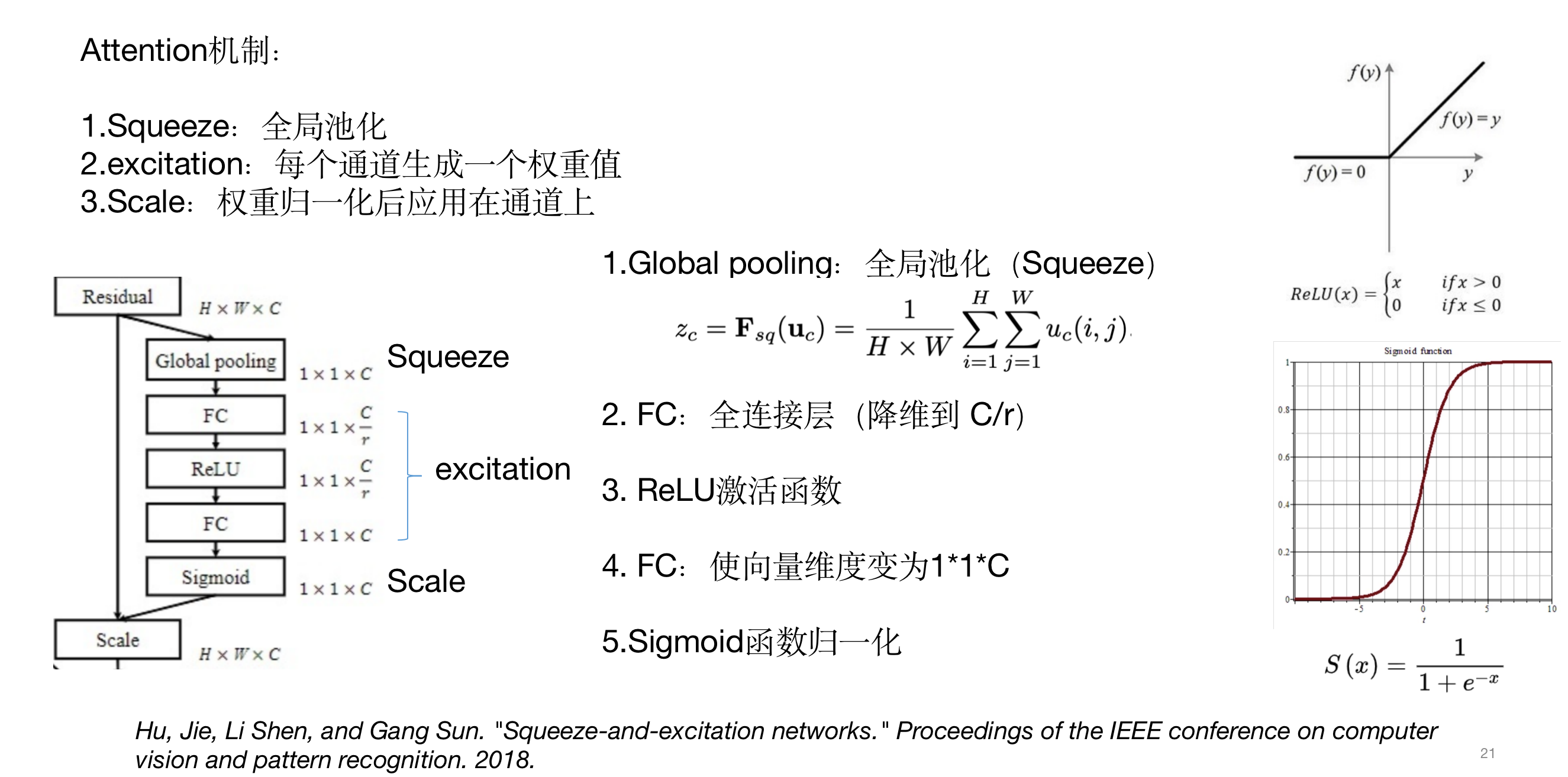文章目录
- 一、通道注意力机制简介
- 二、通道注意力机制pytorch代码
- 1. 单独使用通道注意力机制的小案例
- 2. 使用通道注意力机制的小案例
一、通道注意力机制简介
下面的图形象的说明了通道注意力机制

二、通道注意力机制pytorch代码
通道注意力机制的pytorch代码如下:
import torch
import torch.nn as nn
import torch.utils.data as Data
class ChannelAttention(nn.Module):
def __init__(self, in_planes, ratio=16):
super(ChannelAttention, self).__init__()
self.avg_pool = nn.AdaptiveAvgPool2d(1)
self.max_pool = nn.AdaptiveMaxPool2d(1)
self.fc1 = nn.Conv2d(in_planes, in_planes // ratio, 1, bias=False)
self.relu1 = nn.ReLU()
self.fc2 = nn.Conv2d(in_planes // ratio, in_planes, 1, bias=False)
self.sigmoid = nn.Sigmoid()
def forward(self, x): # x 的输入格式是:[batch_size, C, H, W]
avg_out = self.fc2(self.relu1(self.fc1(self.avg_pool(x))))
max_out = self.fc2(self.relu1(self.fc1(self.max_pool(x))))
out = avg_out + max_out
return self.sigmoid(out)
1. 单独使用通道注意力机制的小案例
import torch
import torch.nn as nn
import torch.utils.data as Data
class ChannelAttention(nn.Module):
def __init__(self, in_planes, ratio=16):
super(ChannelAttention, self).__init__()
self.avg_pool = nn.AdaptiveAvgPool2d(1)
self.max_pool = nn.AdaptiveMaxPool2d(1)
self.fc1 = nn.Conv2d(in_planes, in_planes // ratio, 1, bias=False)
self.relu1 = nn.ReLU()
self.fc2 = nn.Conv2d(in_planes // ratio, in_planes, 1, bias=False)
self.sigmoid = nn.Sigmoid()
def forward(self, x):
avg_out = self.fc2(self.relu1(self.fc1(self.avg_pool(x))))
max_out = self.fc2(self.relu1(self.fc1(self.max_pool(x))))
out = avg_out + max_out
return self.sigmoid(out)
def get_total_train_data(H, W, C, class_count):
"""得到全部的训练数据,这里需要替换成自己的数据"""
import numpy as np
x_train = torch.Tensor(
np.random.random((1000, H, W, C)))
# 维度是 [ 数据量, 高H, 宽W, 长C]
y_train = torch.Tensor(
np.random.randint(0, class_count, size=(1000, 1))).long()
# [ 数据量, 句子的分类], 这里的class_count=4,就是四分类任务
return x_train, y_train
if __name__ == '__main__':
# ================训练参数=================
epochs = 100
batch_size = 30
output_class = 14
H = 40
W = 50
C = 30
# ================准备数据=================
x_train, y_train = get_total_train_data(H, W, C, class_count=output_class)
train_loader = Data.DataLoader(
dataset=Data.TensorDataset(x_train, y_train),
# 封装进Data.TensorDataset()类的数据,可以为任意维度
batch_size=batch_size,
# 每块的大小
shuffle=True,
# 要不要打乱数据 (打乱比较好)
num_workers=6,
# 多进程(multiprocess)来读数据
drop_last=True,
)
# ================初始化模型=================
model = ChannelAttention(in_planes=H)
# ================开始训练=================
for i in range(epochs):
for seq, labels in train_loader:
attention_out = model(seq)
seq_attention_out = attention_out.squeeze()
for i in range(seq_attention_out.size()[0]):
print(seq_attention_out[i])
可以看到输出是:
tensor([0.4440, 0.5005, 0.5533, 0.4530, 0.5494, 0.5430, 0.4911, 0.5339, 0.4627,
0.5182, 0.4940, 0.4497, 0.4544, 0.5337, 0.4663, 0.4333, 0.5343, 0.4335,
0.4711, 0.4569, 0.4508, 0.4532, 0.5102, 0.4824, 0.5231, 0.5328, 0.5092,
0.5567, 0.5075, 0.5520, 0.5588, 0.4344, 0.5577, 0.4408, 0.4539, 0.4891,
0.4513, 0.4472, 0.4983, 0.4991], grad_fn=<SelectBackward>)
tensor([0.4444, 0.5005, 0.5530, 0.4533, 0.5491, 0.5427, 0.4911, 0.5337, 0.4630,
0.5181, 0.4940, 0.4500, 0.4546, 0.5335, 0.4665, 0.4337, 0.5341, 0.4339,
0.4713, 0.4572, 0.4511, 0.4535, 0.5101, 0.4825, 0.5229, 0.5326, 0.5092,
0.5564, 0.5074, 0.5516, 0.5584, 0.4348, 0.5574, 0.4412, 0.4541, 0.4892,
0.4516, 0.4475, 0.4983, 0.4991], grad_fn=<SelectBackward>)
.......
这个就是每个batch中,每层的权重,其中输入模型的size是[30, 40, 50, 30],输出的attention_out的size是[30, 40, 1, 1]
2. 使用通道注意力机制的小案例
import torch
import torch.nn as nn
import torch.utils.data as Data
class ChannelAttention(nn.Module):
def __init__(self, in_planes, ratio=16):
super(ChannelAttention, self).__init__()
self.avg_pool = nn.AdaptiveAvgPool2d(1)
self.max_pool = nn.AdaptiveMaxPool2d(1)
self.fc1 = nn.Conv2d(in_planes, in_planes // ratio, 1, bias=False)
self.relu1 = nn.ReLU()
self.fc2 = nn.Conv2d(in_planes // ratio, in_planes, 1, bias=False)
self.sigmoid = nn.Sigmoid()
def forward(self, x):
avg_out = self.fc2(self.relu1(self.fc1(self.avg_pool(x))))
max_out = self.fc2(self.relu1(self.fc1(self.max_pool(x))))
out = avg_out + max_out
return self.sigmoid(out)
class UseAttentionModel(nn.Module): # 这里可以随便定义自己的模型
def __init__(self, H):
super(UseAttentionModel, self).__init__()
self.channel_attention = ChannelAttention(H)
def forward(self, x):
# 反向传播
attention_value = self.channel_attention(x)
out = x.mul(attention_value) # 得到借助注意力机制后的输出
return out
def get_total_train_data(H, W, C, class_count):
"""得到全部的训练数据,这里需要替换成自己的数据"""
import numpy as np
x_train = torch.Tensor(
np.random.random((1000, H, W, C)))
# 维度是 [ 数据量, 高H, 宽W, 长C]
y_train = torch.Tensor(
np.random.randint(0, class_count, size=(1000, 1))).long()
# [ 数据量, 句子的分类], 这里的class_count=4,就是四分类任务
return x_train, y_train
if __name__ == '__main__':
# ================训练参数=================
epochs = 100
batch_size = 30
output_class = 14
H = 40
W = 50
C = 30
# ================准备数据=================
x_train, y_train = get_total_train_data(H, W, C, class_count=output_class)
train_loader = Data.DataLoader(
dataset=Data.TensorDataset(x_train, y_train),
# 封装进Data.TensorDataset()类的数据,可以为任意维度
batch_size=batch_size,
# 每块的大小
shuffle=True,
# 要不要打乱数据 (打乱比较好)
num_workers=6,
# 多进程(multiprocess)来读数据
drop_last=True,
)
# ================初始化模型=================
model = UseAttentionModel(H)
cross_loss = nn.CrossEntropyLoss()
optimizer = torch.optim.Adam(model.parameters(), lr=0.001)
# 优化器
model.train()
# ================开始训练=================
for i in range(epochs):
for seq, labels in train_loader:
attention_out = model(seq)
print(attention_out.size())
print(attention_out)
最后
以上就是糟糕火车最近收集整理的关于注意力机制学习(一)——通道注意力与pytorch案例一、通道注意力机制简介二、通道注意力机制pytorch代码的全部内容,更多相关注意力机制学习(一)——通道注意力与pytorch案例一、通道注意力机制简介二、通道注意力机制pytorch代码内容请搜索靠谱客的其他文章。
本图文内容来源于网友提供,作为学习参考使用,或来自网络收集整理,版权属于原作者所有。








发表评论 取消回复